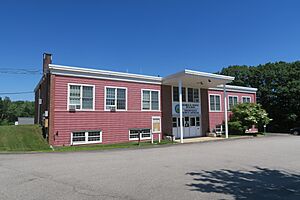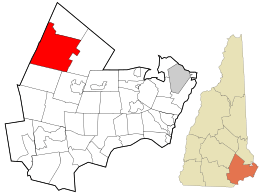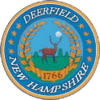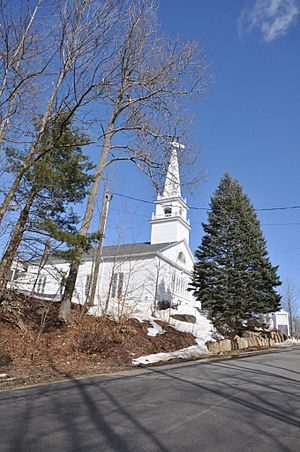Deerfield, New Hampshire facts for kids
Quick facts for kids
Deerfield, New Hampshire
|
||
|---|---|---|

Town hall
|
||
|
||

Location in Rockingham County and the state of New Hampshire.
|
||
| Country | United States | |
| State | New Hampshire | |
| County | Rockingham | |
| Incorporated | 1766 | |
| Villages |
|
|
| Area | ||
| • Total | 52.10 sq mi (134.93 km2) | |
| • Land | 50.76 sq mi (131.46 km2) | |
| • Water | 1.34 sq mi (3.47 km2) 2.57% | |
| Elevation | 515 ft (157 m) | |
| Population
(2020)
|
||
| • Total | 4,855 | |
| • Density | 96/sq mi (36.9/km2) | |
| Time zone | UTC-5 (Eastern) | |
| • Summer (DST) | UTC-4 (Eastern) | |
| ZIP code |
03037
|
|
| Area code(s) | 603 | |
| FIPS code | 33-17460 | |
| GNIS feature ID | 0873576 | |
Deerfield is a town located in Rockingham County, New Hampshire, in the United States. In 2020, about 4,855 people lived here. That's more than the 4,280 people who lived here in 2010! Deerfield is famous for its yearly event, the Deerfield Fair.
Contents
Discovering Deerfield's Past
Deerfield was once part of a larger town called Nottingham. In 1756, people living there asked to form their own separate area, but they were told no.
How Deerfield Got Its Name
In 1765, while waiting for another chance to become a separate town, two local hunters gave a deer to the colonial governor, Benning Wentworth. Because of this gift, permission was finally given. The town was officially created in 1766 and named "Deerfield."
The document that made Deerfield a town was signed by three members of the Leavitt family. One of them, Captain Samuel Leavitt, later became one of the town's first leaders. Leavitts Hill in Deerfield is named after this family. They first settled in nearby Exeter.
Deerfield Parade: A Historic Spot
"Deerfield Parade" is a hilltop area that was first settled around 1740. It was an important stop on the early mail route between Concord and Portsmouth.
This area was also where soldiers from the Revolutionary War and the Civil War would train. They would "parade" on the village common. The "Parade" was a busy center for jobs, culture, and trade. Around 1798, people in Deerfield started a high school called Deerfield Academy. Sadly, it burned down in 1842.
The Deerfield Fair
Deerfield was once a busy farming community. People were disappointed when the railroads didn't come through their town. So, in 1876, the town started the Deerfield Fair.
Today, the Deerfield Fair is known as "New England's Oldest Family Fair." This four-day event happens every autumn. It brings in many people who come to see animals, farm products, and handmade crafts. Visitors also enjoy the fun amusement park rides.
Exploring Deerfield's Geography
Deerfield is located in the southeastern part of New Hampshire. It sits on the western side of Rockingham County. The western edge of the town borders Merrimack County.
Mountains and Parks
The highest point in Deerfield, and in all of Rockingham County, is the top of Nottingham Mountain. It is about 1,345 feet (410 meters) above sea level. This mountain is near the town's western border.
Some parts of the Pawtuckaway Mountains are along the eastern border of Deerfield. This includes a small section of Pawtuckaway State Park. A part of Bear Brook State Park is also in the southwestern corner of Deerfield. This includes the camping area at Spruce Pond and Beaver Pond.
Rivers and Waterways
Deerfield covers about 52.1 square miles (134.9 square kilometers). Most of this area is land, with about 1.3 square miles (3.5 square kilometers) being water.
The town's water mostly flows into the Lamprey River and its smaller river, the North Branch River. These rivers are part of the Piscataqua River watershed, which flows to the coast. The western and northern parts of Deerfield drain into the Merrimack River watershed.
Neighboring Towns
Deerfield shares its borders with several other towns:
- Northwood, New Hampshire (to the north)
- Nottingham, New Hampshire (to the east)
- Raymond, New Hampshire (to the southeast)
- Candia, New Hampshire (to the south)
- Allenstown, New Hampshire (to the west)
- Epsom, New Hampshire (to the northwest)
People of Deerfield
In 2000, there were 3,678 people living in Deerfield. Most of the people living here were White (98.53%). About 0.30% of the population was Hispanic or Latino.
The average household had about 2.98 people. The average family had about 3.27 people. In 2000, the average income for a household was $61,367. For families, it was $64,737. In 2022, the average household income was $119,375.00.
Getting Around Deerfield
Two main New Hampshire state routes pass through Deerfield. These roads help people travel to and from the town.
- NH 43 connects Deerfield to Candia in the south and Northwood in the north.
- NH 107 connects Deerfield to Raymond in the south and Epsom in the north.
Education in Deerfield
Deerfield has one public school, the Deerfield Community School. It is located on North Road. This school teaches students from Pre-Kindergarten up to 8th grade.
The Deerfield Community School opened in 1990. It replaced the older George B. White School. The old George B. White Building is now used for town offices and the police department.
Deerfield does not have its own high school. Students who graduate from Deerfield Community School usually go to Concord High School. Some students may also have the chance to attend other high schools nearby.
Community Groups
Deerfield is home to several active community groups:
- Troop 138 of the Boy Scouts of America
- The American Legion
Famous People From Deerfield
Many interesting people have come from Deerfield:
- Benjamin Franklin Butler (1818–1893): A general during the Civil War. He also served as a U.S. congressman and was the 33rd governor of Massachusetts.
- Josiah Butler (1779–1854): A U.S. congressman.
- Julia Knowlton Dyer (1829–1927): A person known for giving money to good causes.
- Lorenzo D. Harvey (1848–1922): He was in charge of public education in Wisconsin in the late 1800s and early 1900s.
- Benning Wentworth Jenness (1806–1879): A U.S. senator.
- Mary Stuart James MacMurphy (1846–1934): A teacher, speaker, club member, and writer.
- Major John Simpson (1748–1825): A soldier in the Revolutionary War. He is thought to be one of the first people to fire a shot at the Battle of Bunker Hill.
- Nathaniel Upham (1774–1829): A U.S. congressman.
See also
 In Spanish: Deerfield (Nuevo Hampshire) para niños
In Spanish: Deerfield (Nuevo Hampshire) para niños



